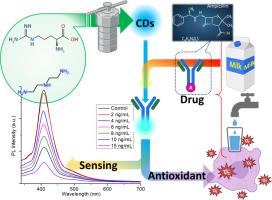生物相容性掺杂碳点荧光检测乳制品和生活用水中的抗生素
IF 5.7
3区 材料科学
Q2 MATERIALS SCIENCE, MULTIDISCIPLINARY
引用次数: 0
摘要
食品和水中抗生素残留的鉴定对公共卫生和环境保护至关重要。本研究利用l-精氨酸和二乙烯三胺作为富氮前体合成碳点(ADCDs)来放大荧光特性。利用x射线衍射(XRD)、傅里叶变换红外光谱(FTIR)和x射线光电子能谱(XPS)对ADCDs的结构和化学成分进行了验证,证实了ADCDs的有效掺杂和表面功能化。合成的HCDs具有较强的荧光性、良好的水分散性和光稳定性,可用于牛奶和自来水中氨苄西林的选择性检测。实际样品的研究显示出较高的回收率(82.00 % - 98.77%)和较低的相对标准偏差(RSD),从而验证了传感器的精度和一致性。MTT试验和成纤维细胞增殖分析显示细胞存活率超过80%,证实了纳米材料的生物安全性。绿色合成、本征掺杂和荧光传感的结合为抗生素监测提供了一种经济有效的方法。本文章由计算机程序翻译,如有差异,请以英文原文为准。

Fluorescent detection of antibiotics in dairy products and household water using biocompatible doped carbon dots
The identification of antibiotic residues in food and water is essential for public health and environmental protection. This study involved the synthesis of carbon dots (ADCDs) utilizing l-arginine and diethylenetriamine as nitrogen-rich precursors to amplify fluorescence characteristics. The structural and chemical content of ADCDs was validated using X-ray diffraction (XRD), Fourier-transform infrared spectroscopy (FTIR), and X-ray photoelectron spectroscopy (XPS), confirming effective doping and surface functionalization. The synthesized H![]() CDs demonstrated robust fluorescence, superior water dispersibility, and remarkable photostability, facilitating the selective detection of ampicillin in milk and tap water. The study of the actual sample exhibited elevated recovery rates (82.00 %–98.77 %) alongside a low relative standard deviation (RSD), so validating the sensor's precision and consistency. MTT assays and fibroblast proliferation analysis demonstrated over 80 % cell viability, confirming the biosafety of the nanomaterial. The integration of green synthesis, intrinsic doping and fluorescence-based sensing offers a cost-effective and efficient method for antibiotic monitoring.
CDs demonstrated robust fluorescence, superior water dispersibility, and remarkable photostability, facilitating the selective detection of ampicillin in milk and tap water. The study of the actual sample exhibited elevated recovery rates (82.00 %–98.77 %) alongside a low relative standard deviation (RSD), so validating the sensor's precision and consistency. MTT assays and fibroblast proliferation analysis demonstrated over 80 % cell viability, confirming the biosafety of the nanomaterial. The integration of green synthesis, intrinsic doping and fluorescence-based sensing offers a cost-effective and efficient method for antibiotic monitoring.
求助全文
通过发布文献求助,成功后即可免费获取论文全文。
去求助
来源期刊

Materials Research Bulletin
工程技术-材料科学:综合
CiteScore
9.80
自引率
5.60%
发文量
372
审稿时长
42 days
期刊介绍:
Materials Research Bulletin is an international journal reporting high-impact research on processing-structure-property relationships in functional materials and nanomaterials with interesting electronic, magnetic, optical, thermal, mechanical or catalytic properties. Papers purely on thermodynamics or theoretical calculations (e.g., density functional theory) do not fall within the scope of the journal unless they also demonstrate a clear link to physical properties. Topics covered include functional materials (e.g., dielectrics, pyroelectrics, piezoelectrics, ferroelectrics, relaxors, thermoelectrics, etc.); electrochemistry and solid-state ionics (e.g., photovoltaics, batteries, sensors, and fuel cells); nanomaterials, graphene, and nanocomposites; luminescence and photocatalysis; crystal-structure and defect-structure analysis; novel electronics; non-crystalline solids; flexible electronics; protein-material interactions; and polymeric ion-exchange membranes.
 求助内容:
求助内容: 应助结果提醒方式:
应助结果提醒方式:


